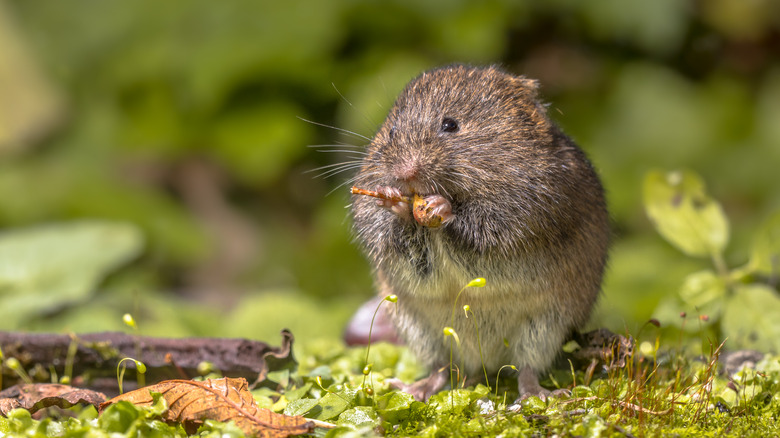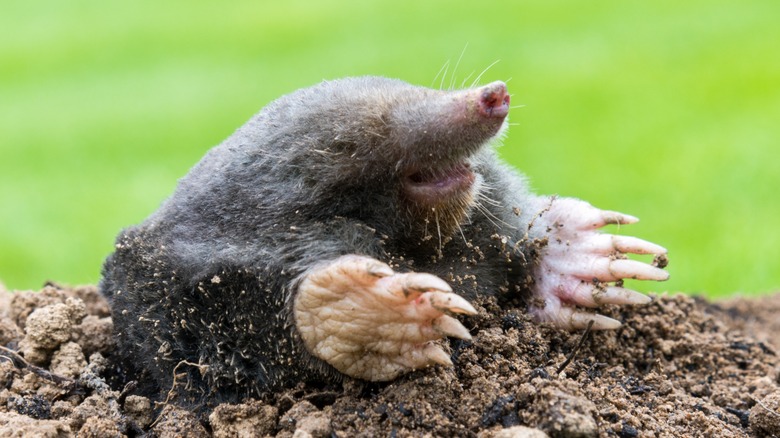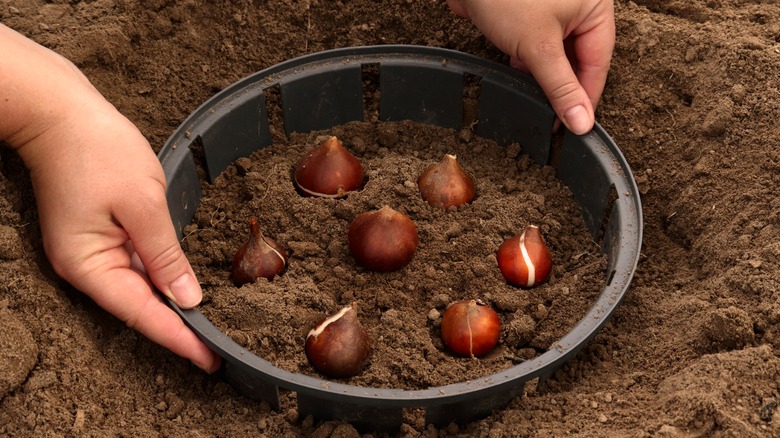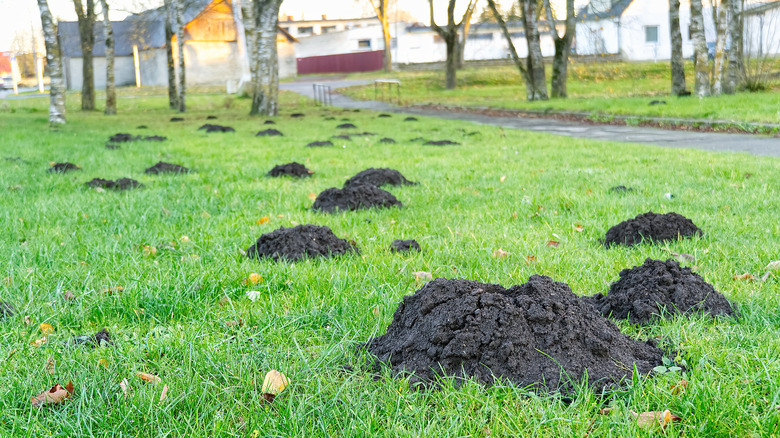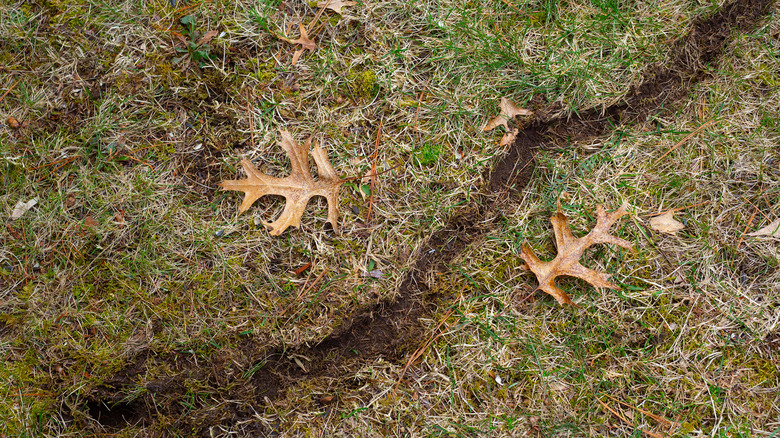Voles Vs. Moles: What's The Difference?
Voles or moles? Both are small mammals 4 to 6 inches in length, with behaviors believed to wreak havoc on the landscape. Aside from that, and their rhyming names, their similarities are few.
Voles are rodents; the most common species is the meadow mouse, while moles are considered insectivores, a classification Britannica says is shared with hedgehogs. Voles are reddish or brown, while moles are typically dark gray. The snout of a vole is blunt, and its front teeth are long and sharp — suited for gnawing and chewing a vegetarian diet. A mole's nose is tapered and sensitive; paired with pointed teeth, it's well adapted for locating and consuming an insectivore diet.
Moles dig for prey, sculpting subterranean housing and highways. Voles travel these tunnels but make their nests above ground. According to Bob Vila, they're more likely to create "runways," channels of chomped grass in service to finding tasty morsels.
The appearances of voles and moles
A mole is equipped with the physical attributes for an underground (fossorial) existence. The understanding that moles are blind is untrue. Per Live Science, they are color-blind, and have very small eyes which function minimally, detecting movement and changes in light. What they lack in sight they make up for with an amazing sense of smell. The American Museum of Natural History claims that the nose of the star-nose mole is adorned with 22 sensing, finger-like protrusions and covered in 25,000 microscopic receptors which can detect odors underwater. Though moles have no external ears, their hearing is acute, which aids in hunting prey. With oversized flat "hands" and strong claws, they have built-in shovels perfect for excavation.
Voles have dark eyes and large, rounded ears; they are the classic picture of a country field mouse. A portly shape and shorter tail will alert you of its true identity as a vole. (A mouse tail is as long as its lither body.) The smallest vole weighs in at less than 1 ounce, with the largest nine times that. Fast runners, they scamper and scurry, hiding from predators day and night while seeking out food.
The diets of voles and moles
According to Live Science, moles collect and dine on earthworms, first biting off their heads! Voles gleefully chew through newly planted tulip bulbs. We're not sure which image is more horrifying.
The diets of voles and moles push one toward agriculturally beneficial and the other toward being a nuisance. The beetles, grubs, and larvae moles eat would not be missed by the gardener — actually it's free pest control. Voles however, can be a gardener's foe. Subsisting on various vegetation, including roots, bulbs, tubers, bark (particularly of fruit trees), and vegetables, their procurement of food can cause damage to the landscape or smaller windfalls come harvest.
The shelters of voles and moles
Moles construct complex underground networks. Per Pets on Mom, temporary tunnels near the surface are created while eating, or used to travel, avoiding predators and extremes of weather. More permanent burrows are dug deeper, as much as 3 feet below ground, and function as nests. Some chambers have specific purposes as bedrooms, kitchens, or birthing areas, which are lined and fluffed with plant material. It's not uncommon for moles to live in the same tunnels for generations. Live Science claims that moles are very independent, spending the majority of their time alone in these subterranean burrows — you'll be hard pressed to find more than five in 1 acre of land.
Voles are responsible for some of the dirt mounds and hillocks dotting your yard. The underground passages causing them are also constructed to provide safety from predators, and are often used by several voles simultaneously. However, they are not created for shelter. According to Penn State Extension, they weave their nests out of dry grass and tuck them under low vegetation or into sheltered areas, such as tree roots, woodpiles, or construction debris.
Which animal creates more damage?
Homeowners shouldn't concern themselves about the potential of voles and moles as indoor pests. Neither animal has interest in taking up residence in a built structure, leaving the habitats of their food sources. Even in winter, these non-hibernating mammals prefer to be in their outdoor nests, or hunting beneath the snow.
Prolific diggers, per Iowa State University, one mole can burrow at a rate of 18 feet per hour. The depth of their tunneling and resulting destabilization of the soil can have lasting and dire effects. Water diverted there creates flooding and drainage issues, while freezing and subsequent thawing of the water can damage foundations.
According to Penn State Extension, voles can be a monumental detriment to farmers, orchardists, and gardeners alike. They cause injury to seedlings and mature trees in the stripping of their bark (called girdling), which makes them more susceptible to disease, temperature extremes, and Love to Know asserts, less efficient at water and energy transmission. They feast on roots and crops – Bob Vila explains that voles can eat up to 60% of their body weight per day — and their tunnels may impact whole areas of plantings.
How to deter voles and moles
"An ounce of prevention is worth a pound of cure." That's an apt saying in regard to these tiny creatures, where the very best defense is deterrence. Bob Vila recommends making the area less welcoming to voles by limiting options for shelter and safe feeding: Trim vegetation, go easy on gardening mulch, and maintain leaf and snow removal. Minimize food supply: Wrap tree trunks, pick up fallen fruit, and fence the garden. The Spruce suggests diminishing a mole's major food source in the yard — grubs — and employing wind chimes, radios, or ultrasonic stakes to irritate and scare them.
Per Outdoor Alive, natural repellants, like coffee grounds and cayenne pepper, are effective when placed throughout burrows and areas of activity. An easily acquired and common product is formulated with castor oil, which they both detest the odor of. (Remember, moles have sensitive snoots!)
Baits and traps are available, but first consider whether the problem is cosmetic or ... deeper than that. Voles and moles contribute to the landscape's ecosystem, helping to control insect populations and providing a food source for other species. Though they can be unsightly, mounds of displaced dirt and scarred turf also result in soil aeration and the spread of nutrients. And fewer bugs.
